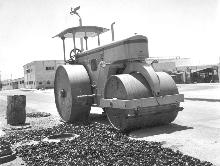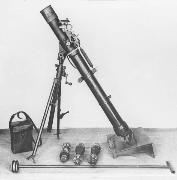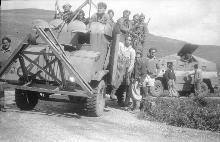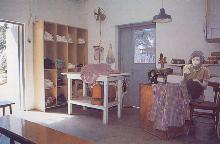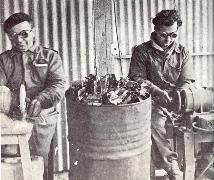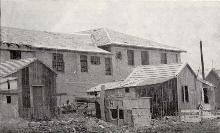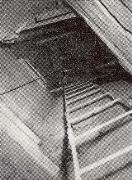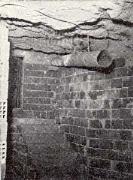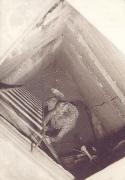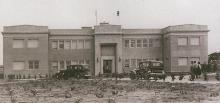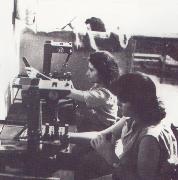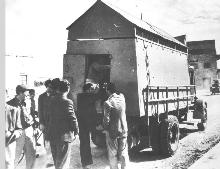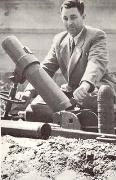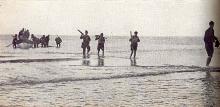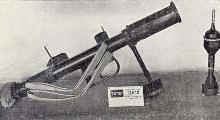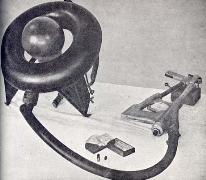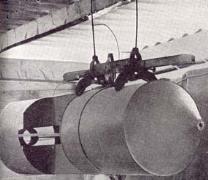| Covert weapon manufacturing and purchasing |
Ta'as- Clandestine Military Industries The Hagana's own weapons manufacturing system. The second source of Hagana armament, aside from purchased weapons, was arms manufacturing. The goal was to diminish the organization's dependency on purchased weapons. Manufacturing began with the first hand grenades created in the Arab bloody rioting of 1929, named "Menahamiot" after their creator Menachem Ben-Guri, continued with the manufacturing of sub machine-guns, mortars, varied munitions and culminated with the Davidka, named after its creator David Leibowitz - the Yishuv's secret weapon during the War of Independence. The private weapons industry was initiated by individuals with technical knowledge in collaboration with Hagana commanders. It developed into a successful covert industry manufacturing ammunition, explosives and weapons. The term Ta'as- Clandestine Military Industries was first coined in 1933 and was used for all weapon factories and shops. Ta'as faced 2 main problems: a. Acquiring technical information and necessary machinery for manufacturing of weapons. b. Concealing the factories and shops from the British. The first problem was solved by the ingenuity of Ta'as members who smuggled in models and various technical machinery (amongst the smugglers were the Aharon brothers and Efraim Katzir, who was later elected the President of Israel). The factories were camouflaged and concealed in various ways. By 1940, 7 Ta'as factories had already been established. They manufactured mortars, bombs and explosives. Many were situated in Tel-Aviv, disguised as civilian factories, shops and work shops. As manufacturing developed, the factories were scattered all over the country, in cities and in Kibbutzim where they remained covert. Only 2 factories were exposed throughout the entire struggle against the British. The factories were given code names such as Q Factory, a bullet manufacturing factory; S Factory established on Solel Boneh grounds in Giv'ataym; R.A.F institute in Kibbutz Sedot -Yam which inlaid the fuses into grenades made of aluminum salvaged from a R.A.F plane that crashed near the Kibbutz. Products had code names as well: the English Sten was called T.A.M.A.T meaning Ta'as sub machine-gun. The bullets were named U.S.A meaning in Yiddish: "onzere shtickle arbeit" (our own piece of work). Ta'as factories were shut down periodically and moved to a different location for concealment reasons. Factories were built underground, for example, the Ayalon Factory that manufactured T.A.M.A.T and Sten bullets. The factory was located in a special underground hall beneath Kibbutzim Hill near Rehovot, and its entrances were disguised as a bakery and a laundry. A Hachshara (a group of people planning to establish a new settlement) lived on the hill itself, and some of the members worked in the factory without the other members knowing of its existence. Ta'as was reorganized into 3 branches in 1947. Maflan- weapon manufacturing factories; Maflat- ammunition factories; Mafkam- chemical factories: In 1947 a weapons production line was transferred from U.S.A. On the eve of the War of Independence, Ta'as has 300 workers, and due to the war, their number increased greatly. 10,000 sub- machine-guns plus ammunition, anti tank weapons, mortars, mortar shells and aircraft bombs were manufactured by the time of the declaration of independence. In spite of limitations and minimal resources, Ta'as's contribution to the War of Independence was vital and crucial. It became one of the country's largest industry- The Military Industries. Weapon purchase A general term for all Hagana weapons procurement operations. Purchase acted as the main weapons supply source for Hagana members: for training and protection and actions against the Arabs and the British. Purchase operations were highly confidential, since British Mandate laws forbade the purchase and possession of weapons. Those who had weapons in their possession, if caught, faced harsh punishments and their weapons were confiscated. Dozens of Hagana members were imprisoned for possession and transportation of weapons. Settlers lent their privately owned weapons to the Hagana members during its early stage. Later on, weapons purchased by Hagana were distributed or sold to the settlements and the income from the sales was used to purchase more weapons. Weapons were bought both in Palestine and abroad and were smuggled into the country using various methods. During the 1940's there were 3 main sources for purchasing weapons: a. Weapons and ammunition were bought from anybody in Palestine or abroad, WW I & 2 army surplus was purchased in Europe and U.S.A. b. During World War II, Jewish volunteers and Hagana members serving in the British army collected weapons left on the battle fields and brought them back to Palestine. c. Weapons and ammunitions stolen from British Army Camps. Weapon smuggling into the country varied and required sophisticated and creative solutions. For example, during one of the successful purchase operations at the beginning of the Hagana, 15 mid weight machine guns were hidden and transferred in a cement mixer to Beirut harbor and from there were carried in carts to Kefar Gil'adi. Later on weapons were smuggled in immigrant's luggage, cement barrels, engines and washing machines. As a result, most of the weapons were outdated which made it almost impossible to find suitable ammunition. On the eve of the War of Independence it was clear that the weapons purchased by Hagana were unsuitable. David Ben-Gurion ordered the increase of the purchase budget, and members were required to increase weapon purchases to include various heavy weaponry: cannons, armored vehicles and aircrafts. Large quantities of weapons started arriving in Israel from April, 1948 and onwards. As the War of Independence continued, "Rechesh" - Purchase members had to overcome the embargo imposed by the US against weapon sales to both sides. The largest purchases were made in eastern block countries, especially in Czechoslovakia, where the US embargo was ignored. Heavy weapons including aircraft, tanks, armored vehicles and anti tank weapons were gathered in Europe and transported to Palestine. Weapon manufacturing systems were purchased from the US. The Science Corp During the 1930's Hagana members and local scientists started developing weapons. The most remarkable outcome was the manufacturing of ten explosives by Felix Bergman. Following the War of Independence Aharon Katzir and Yohanan Ratner established the Hagana Scientific Research department that conducted various experiments in several academic institutions. Ben-Gurion ordered the establishment of the Hagana's Scientific Research department in October, 1947. Yohanan Ratner headed and managed the department together with Ernest Bergman, Aharon Katzir and others. Shlomo Gur and Aharon Donagy were appointed acting managers. Yevgeni (Zenka) Ratner led weapons development and manufacturing (including an antitank launcher, land mines, smoke bombs etc. The Science Corps (Cheme) was established on the 17th of March, 1948. Zenka Ratner's work and that of scientists from Jerusalem, Rehovot and Haifa, was vital to the corps' activity, among them the prominent work of Efraim Katzir, the Corps' commander. Ernest Bergman was considered to be the most senior group member. The Corps laid the foundations to all Defense system research and development activities. Purchase & Ta'as: Increase in the amount of weapons from 1,000 in 1929 and up to the War of Independence: Number of Ta'as factories before the war - 46 Number of Ta'as employees in 1940 - 50 Number of Ta'as employees in 1947 - 300 Number of Ta'as employees in 1948 - 1,000 | |||||||||||

